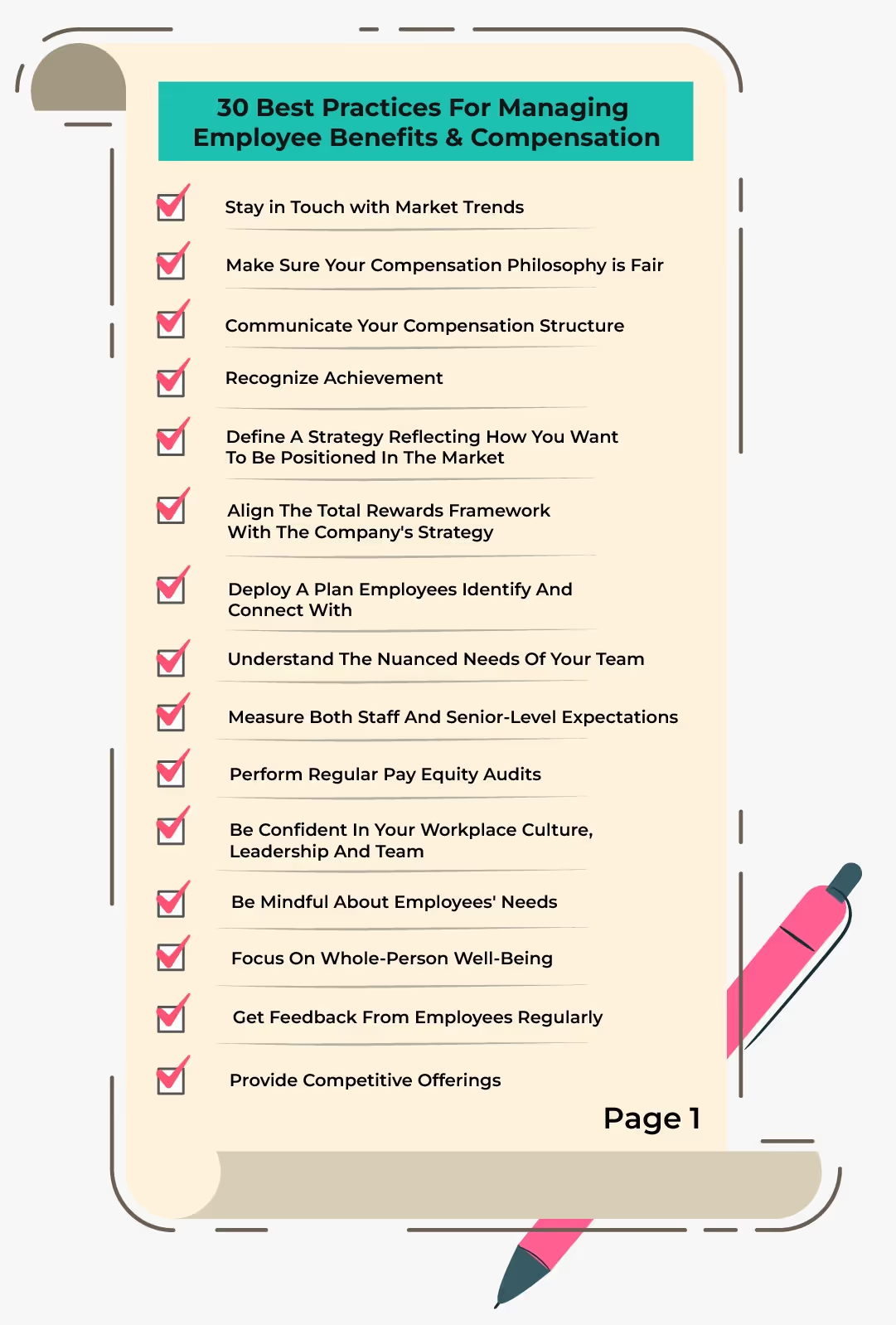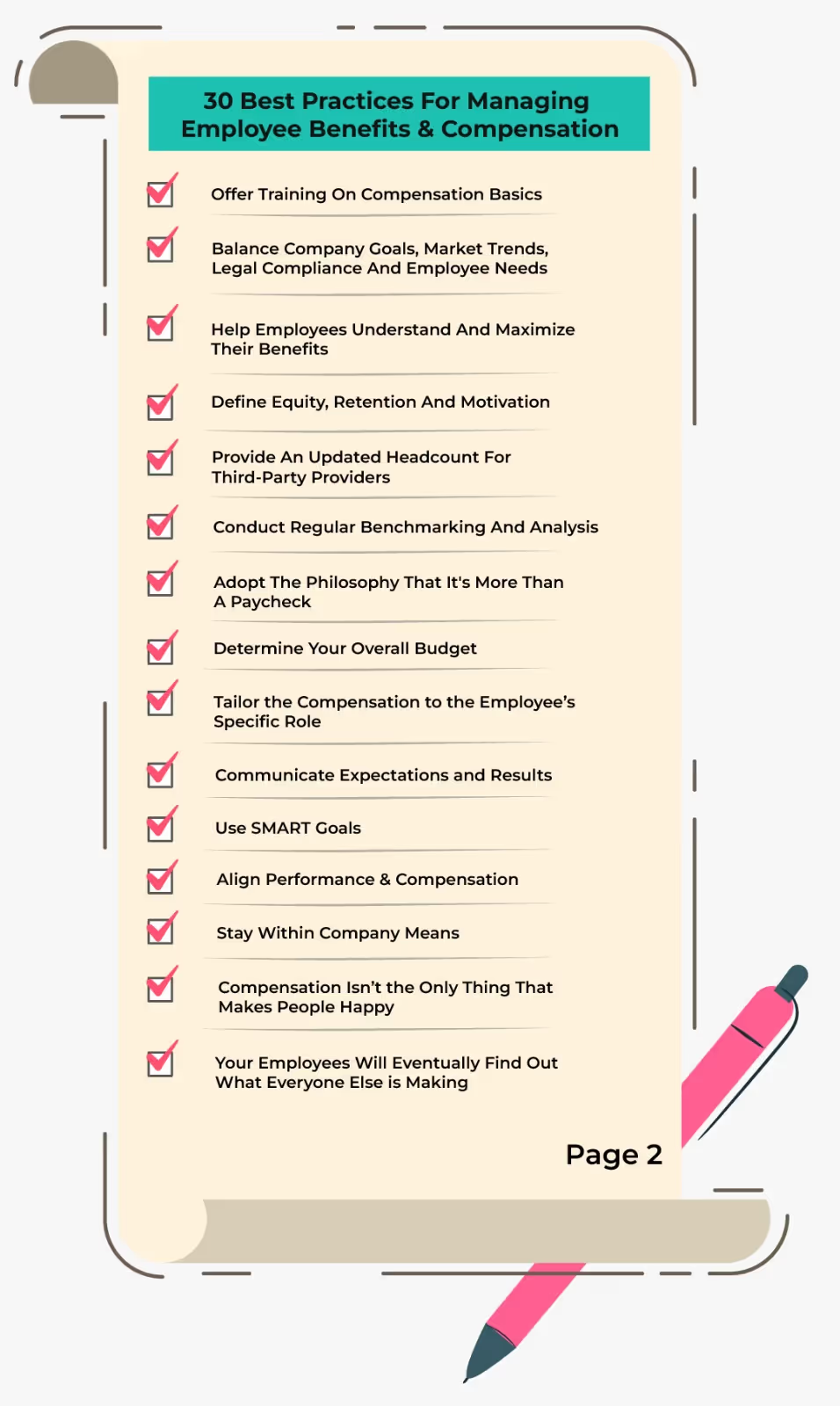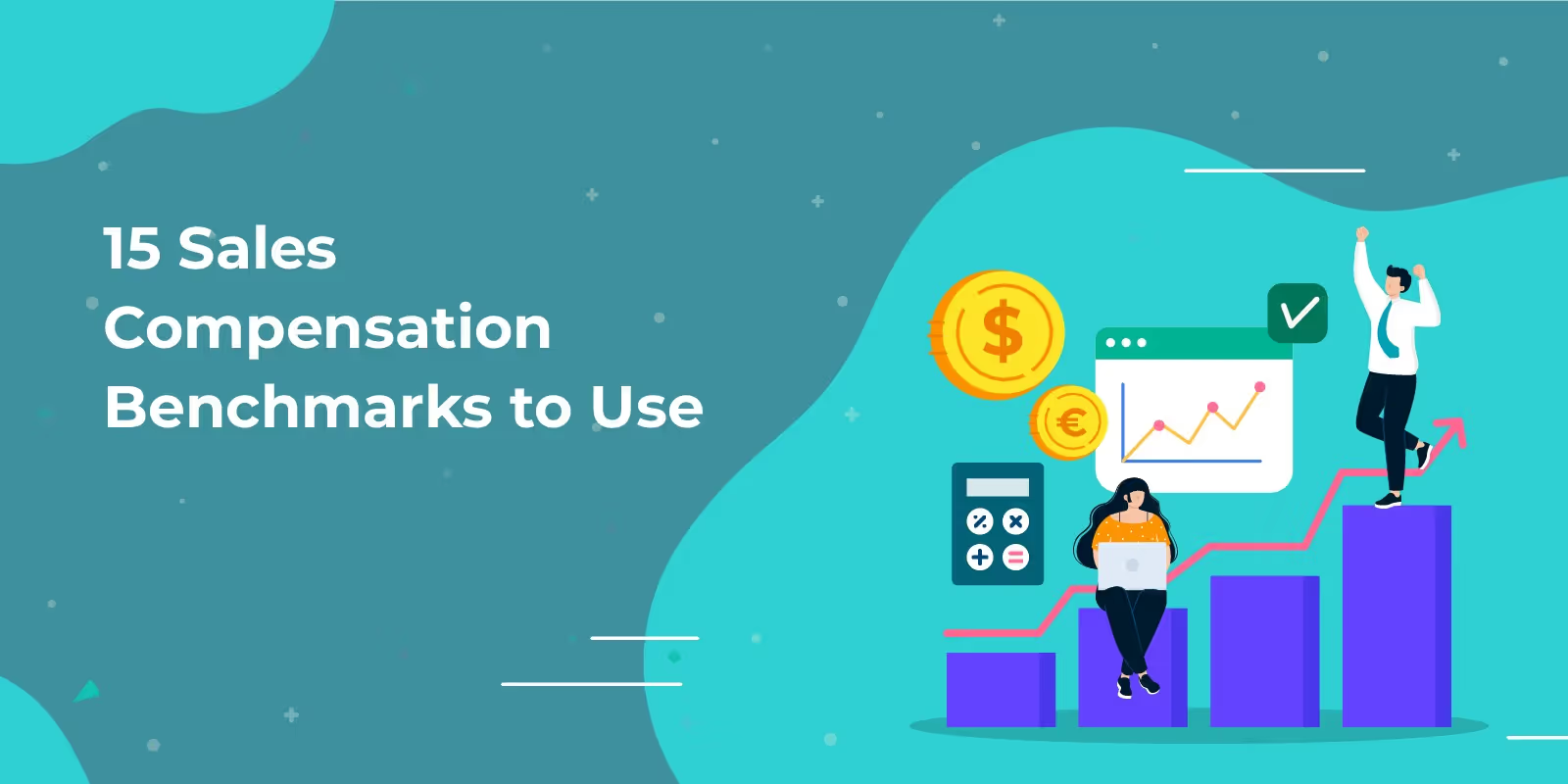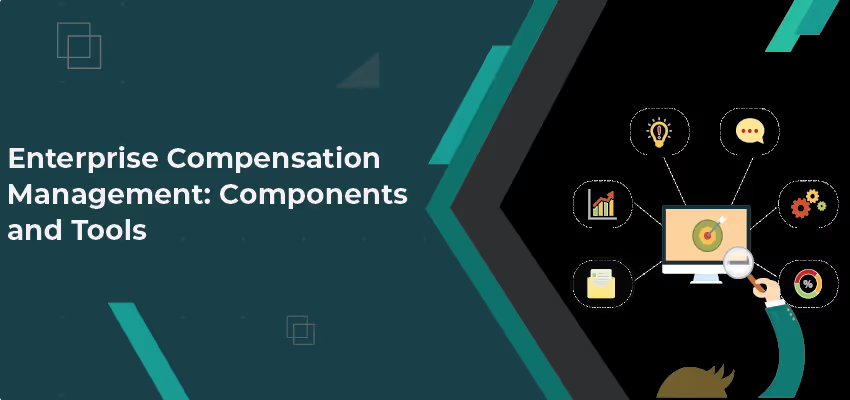
Blog
Top 30 Compensation Best Practices for Modern Workplaces
August 23, 2024


Key Insights
The future of work is here, and it's demanding a new approach to compensation!
Is your company stuck in the compensation stone age? It's time to hit refresh and ditch the dusty old playbook and rewrite the rules of compensation.
Let's be real. Times have changed. The nine-to-five grind and a monthly paycheck just don't cut it anymore. Today's modern-day employees are looking for more than just a salary – they want purpose, flexibility, and a compensation package that reflects their worth!
According to LinkedIn global trends, Companies rated highly on benefits and compensation saw 56% lower attrition than those rated lowerIt's pretty clear that taking care of your employees pays off in the long run.
Let's talk about how to revamp your compensation strategy to attract and retain top talent in this fast-paced, ever-evolving modern work culture.
30 Best Practices for Managing Employee Benefits and Compensation

#1 Stay in Touch with Market Trends
Keeping up with market trends is exactly like following a recipe, if you miss an ingredient, the dish might not turn out right. Regularly reviewing industry standards ensures your compensation packages remain competitive, helping you attract and retain top talent.
#2 Make Sure Your Compensation Philosophy is Fair
Fairness in compensation isn’t just a nice-to-have; it’s a must. It’s almost like setting the rules of a game—everyone needs to know and trust that the game is fair. A transparent and equitable compensation philosophy helps employees feel valued, reducing the chances of dissatisfaction and turnover.
#3 Communicate Your Compensation Structure
Imagine planning a surprise party but not telling anyone when or where it is. Sounds chaotic, right? That’s what it’s like if your compensation structure isn’t clearly communicated. Transparency is key, so make sure your team knows how their compensation is determined and what they can expect.
Not sure how to create a fair sales compensation structure? Our expert blog can help you out! Check it out and get the insights you need to build a structure that works for your team. Give it a read now:
How to Choose the Right Sales Commission Structure?
#4 Recognize Achievement
Recognition is like the cherry on top of a sundae, it makes everything sweeter. Regularly acknowledging your employees’ hard work and achievements boost morale and encourage continued excellence. It doesn’t always have to be monetary; sometimes, a simple “great job” goes a long way.
#5 Define A Strategy Reflecting How You Want to Be Positioned in The Market
Your compensation strategy is like your company’s signature dish, how do you want to be known? Do you want to be seen as a luxury brand or a budget-friendly option? Defining this helps you align your pay and benefits to attract the kind of talent that matches your company’s vision.
#6 Align the Total Rewards Framework with The Company's Strategy
Aligning your rewards framework with your company’s strategy is like matching wine with a meal—when done right, it elevates the experience. Your compensation and benefits should support your overall business goals, ensuring that both the company and employees are moving in the same direction.
#7 Deploy A Plan Employees Identify And Connect With
Your compensation plan should be like a favorite playlist—something employees can relate to and get excited about. When employees see that their rewards align with their personal and professional goals, they’re more likely to stay engaged and committed to the company.

#8 Understand the Nuanced Needs of Your Team
Think of your team as a garden; each plant needs different care to thrive. Understanding the diverse needs of your employees—whether it’s flexibility, health benefits, or career development—allows you to tailor your approach and create a more satisfied and productive workforce.
Happy employees do better work. A study by Gallup has shown that people who love their jobs are almost 21% more productive than those who don't. If you want your team to be top-notch, make sure they feel good about what they do
#9 Measure Both Staff And Senior-Level Expectations
Balancing the expectations of both staff and leadership is like walking a tightrope. You need to ensure that your compensation practices meet the needs of employees at all levels while also aligning with the company’s financial and strategic goals. It’s all about finding that sweet spot where everyone feels valued.
#10 Perform Regular Pay Equity Audits
Pay equity audits are like regular health check-ups for your company. They help you identify any disparities and make necessary adjustments to ensure fairness. Regularly reviewing and addressing pay gaps can prevent bigger issues down the line, like dissatisfaction or even legal challenges.
#11 Be Confident In Your Workplace Culture, Leadership, And Team
Confidence in your workplace culture, leadership, and team is the foundation of a successful compensation strategy. It’s like having a solid house—without a strong foundation, nothing else will stand. When you believe in your team and culture, your compensation practices will naturally reflect that, attracting the right talent.
#12 Be Mindful About Employees' Needs
Being mindful of employees’ needs is like being a good host—you anticipate what your guests might need before they even ask. Whether it’s flexible working hours, mental health support, or professional development opportunities, showing that you care about your employees’ well-being creates a positive and productive work environment.
Deloitte found that in 2023, 64% of millennials would like to have more flexibility in when and where they work. This could be an important indicator to a lot of employers that a growing proportion of their senior team could highly value flexibility.
#13 Focus on Whole-Person Well-Being
Compensation isn’t just about the paycheck; it’s about the whole person. Imagine offering a gym membership but ignoring mental health—it’s like giving someone half a gift. Focusing on whole-person well-being ensures that your employees are happy, healthy, and motivated both at work and in life.
#14 Get Feedback from Employees Regularly
Getting regular feedback from employees is like tuning in to your favorite radio station—you need to listen to know what’s going on. Regular check-ins and surveys help you understand what’s working and what needs improvement, ensuring your compensation strategy stays relevant and effective.
#15 Provide Competitive Offerings
Offering competitive compensation is like being the best restaurant in town—everyone wants to be there. When your pay and benefits are on par with or better than the market, you attract top talent and keep your current employees satisfied and loyal.

#16 Offer Training on Compensation Basics
Training on compensation basics is like giving your employees a roadmap—they need to understand where they’re going and how to get there. When employees know how their pay is structured and what factors influence it, they’re more likely to trust the process and feel confident in their compensation.
#17 Balance Company Goals, Market Trends, Legal Compliance, And Employee Needs
Balancing these elements is like juggling—it takes skill to keep everything in the air. You need to ensure your compensation strategy aligns with company goals, adheres to market trends and legal requirements, and meets employee needs. It’s all about finding the right equilibrium.
#18 Help Employees Understand and Maximize Their Benefits
Helping employees understand and maximize their benefits is like giving them a user manual for a new gadget—they need to know how to use it to get the most out of it. By offering guidance and resources, you ensure that your employees fully appreciate and utilize the benefits you provide.
#19 Define Equity, Retention, And Motivation
Defining equity, retention, and motivation is like setting the rules of engagement—it helps you understand what drives your team and how to keep them. By clearly outlining these concepts in your compensation strategy, you can ensure fairness, encourage loyalty, and inspire performance.
#20 Provide an Updated Headcount for Third-Party Providers
Providing an updated headcount for third-party providers is like keeping your pantry stocked—you need to know what you have to ensure you can meet everyone’s needs. Accurate headcounts help your benefits providers deliver the right level of service and support, ensuring no one falls through the cracks.
#21 Conduct Regular Benchmarking and Analysis
Regular benchmarking and analysis are like checking the weather before a trip, you want to be prepared. By consistently comparing your compensation packages to the market, you can make informed decisions and stay competitive, ensuring you’re always offering fair and attractive benefits.
#22 Adopt the Philosophy That It's More Than a Paycheck
Adopting the philosophy that it’s more than a paycheck is like understanding that a good meal is more than just food—it’s about the experience. Compensation should be seen as part of a larger package that includes career growth, work-life balance, and a positive work environment.
#23 Determine Your Overall Budget
Determining your overall budget is like setting the boundaries for a painting—you need to know your limits to create something beautiful. A well-defined budget ensures that you can offer competitive compensation while maintaining financial stability and supporting the company’s long-term goals.
#24 Tailor the Compensation to the Employee’s Specific Role
Tailoring compensation to the specific role is like picking the right tool for a job—it ensures everything fits perfectly. Different roles have different demands, so your compensation should reflect the unique responsibilities and challenges of each position, making employees feel valued and appropriately rewarded.
#25 Communicate Expectations and Results
Communicating expectations and results is like giving directions—you need to be clear to reach your destination. Regularly discussing what’s expected and how employees are performing helps align everyone’s efforts and ensures that compensation is tied to actual results.
#26 Use SMART Goals
Using SMART goals is like having a GPS for your team—it gives them clear directions and a defined destination. SMART goals (Specific, Measurable, Achievable, Relevant, Time-bound) help employees understand what’s expected and how their performance will be evaluated, leading to more effective and fair compensation.
#27 Align Performance & Compensation
Aligning performance and compensation is like matching the beat to the melody, it creates harmony. When compensation is directly linked to performance, employees are more motivated to excel, knowing their efforts will be rewarded appropriately.
#28 Stay Within Company Means
Staying within the company is like shopping with a budget—you need to be smart about your choices. While it’s important to offer competitive compensation, it should never come at the expense of the company’s financial health. Balance is key to sustainability.
#29 Compensation Isn’t the Only Thing That Makes People Happy
Remember, compensation isn’t the only thing that makes people happy, it’s like icing on the cake, but the cake itself needs to be good. Employees also value things like a positive work environment, opportunities for growth, and work-life balance. A holistic approach to employee satisfaction goes beyond just pay.
#30 Your Employees Will Eventually Find Out What Everyone Else is Making
Transparency in pay is crucial because your employees will eventually find out what everyone else is making, it’s like a secret that’s bound to come out. Being open about your compensation structure from the start helps build trust and reduces the risk of dissatisfaction or turnover when pay discrepancies are discovered.
Automate Incentives and See the Efficiency Soaring!
Look, we're in the age of automation, not spreadsheets. Spending hours crunching numbers for incentive calculations is like using a dial-up modem in a 5G world. It's slow, error-prone, and frankly, a waste of valuable time. Imagine the possibilities if you could automate those calculations, freeing up your team to focus on bigger-picture strategies. Tools like Kennect can handle the heavy lifting, ensuring accurate and timely incentive payouts while giving you the data insights you need to make informed decisions. Book a free demo to know what more it can do for you.
Did you know that payroll errors related to employee benefits cost companies about $140 per employee every year? That might not sound like a lot, but it adds up fast, especially if you're managing a big team. Whether it's payroll, compensation, or benefits, errors are never acceptable anywhere. That's why it's crucial to automate as much as you can. Automation takes the guesswork out of the equation, ensuring everything runs smoothly without those pesky mistakes.
Food For Thought
Harvard says most companies are smart enough to update their plans regularly. 80% of U.S. businesses revise their sales compensation plan every two years or less to ensure they offer the most competitive pay while addressing the challenges sellers face. Are you one of them?
A stale compensation plan is like using a map from the '90s, it's outdated and won't get you where you need to go. Your sales team deserves better. Your compensation plan needs to keep up, or you'll be playing catch-up. Don't get left behind.
We’re in a new age now, gone are the days of one-size-fits-all compensation packages. Just as the world has evolved, so too should your approach to managing employee benefits and compensation.
If your compensation strategy is stuck in the past, you're missing the mark. It’s time to modernize your approach, making it as dynamic and diverse as the people you’re trying to attract and retain. Keep it fresh, fair, and forward-thinking, and you’ll build a team that’s not just satisfied but truly engaged in the journey ahead.
ReKennect : Stay ahead of the curve!
Subscribe to our bi-weekly newsletter packed with latest trends and insights on incentives.
Thank you! Your submission has been received!
Oops! Something went wrong while submitting the form.
Your data is in safe hands. Check out our Privacy policy for more info















